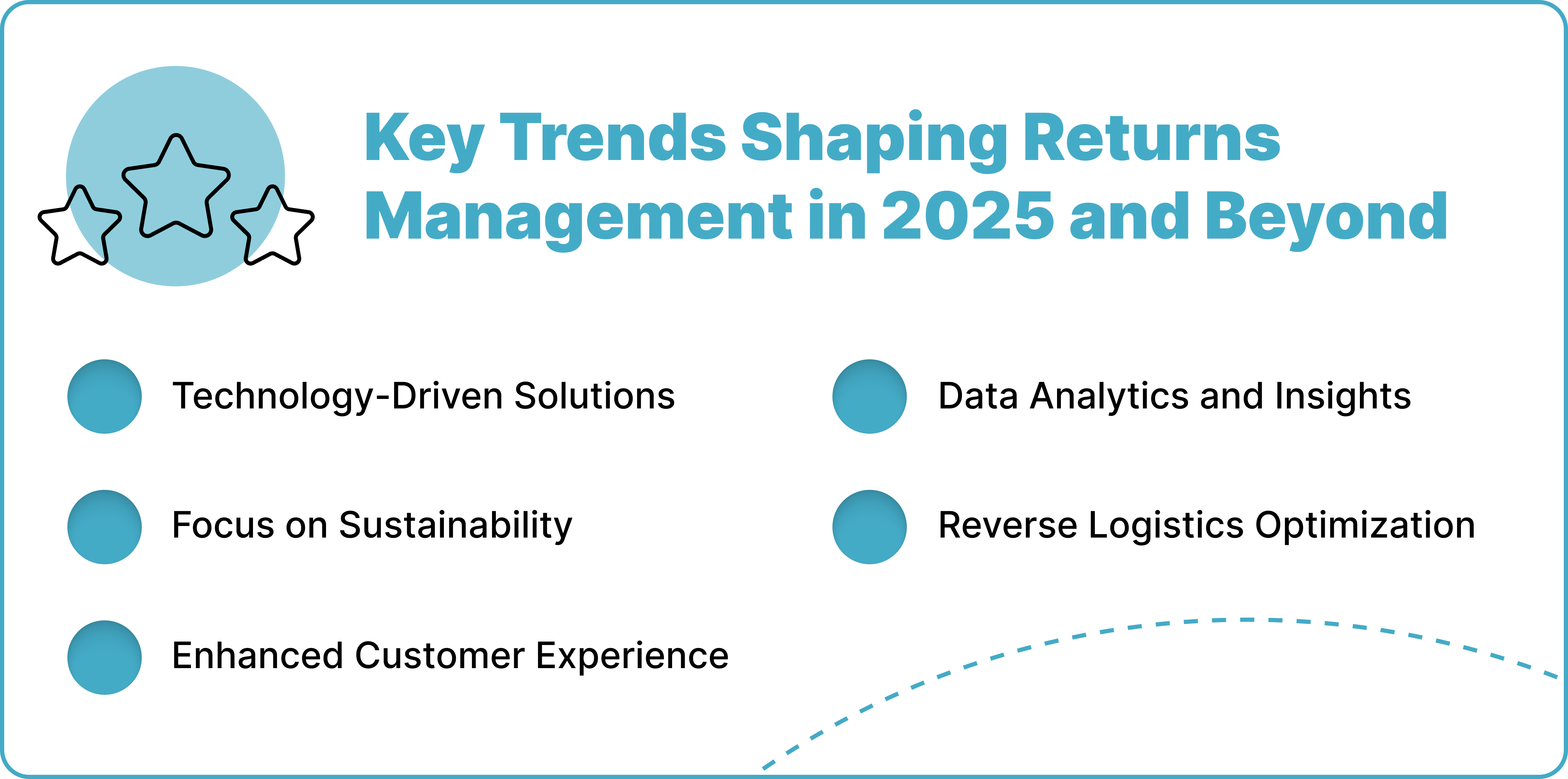The Evolution of Returns Management: Trends in 2025 and Beyond

The success of the e-commerce segment is commonly attributed to the convenience and flexibility it has brought to the lives of shoppers, shaping how consumers think of the buying process today. However, what often gets forgotten in this dialogue is the other side of fulfillment — returns logistics operations.
The success of modern e-commerce and retail rests on how effective its returns management or returns process optimization gets, allowing stakeholders to minimize waste while also ensuring customers get exactly what they want. With the rise of online shopping, more products have been returned than ever for varying reasons, some of which include wrong items delivered or the right item but the wrong fit.
This rise in return traffic presents logistical challenges and opportunities for e-commerce platforms and online retailers. Various returns management trends have emerged to handle these rising volumes, whether through technology or focusing on sustainability. This article explores returns management trends in 2024 and beyond, examining various strategies businesses can adopt to stay ahead.
The Current State of Returns Management
Manual processes, significant costs, and limited visibility into the flow of goods across the returns supply chain operation often characterized the traditional approach to handling product returns. Today, online retailers relying on outdated systems are struggling to meet the increasingly complicated demands of today’s customers, who expect seamless and convenient experiences.
Modern retailers face increased pressure to streamline how they process returns while balancing cost efficiency and customer satisfaction. Innovative solutions to modernize returns management are constantly leveraged to navigate this current environment.
Key Trends Shaping Returns Management in 2025 and Beyond

Although returns process optimization is a key issue for online retailers, it is not the only factor to consider. Online retailers and e-commerce businesses also have to ensure customers are satisfied with how the optimization process is carried out. Then there is the cost factor. All of these have contributed to the following trends:
1. Technology-Driven Solutions
In a world where technology has become mainstream, there is almost no aspect of supply chain management in which tech solutions do not play a significant role. Returns management is not the same. There are several solutions that have allowed online retailers to enhance returns process optimization and streamline the reverse logistics process.
Artificial Intelligence (AI) and Machine Learning
AI is transforming returns management by enabling predictive analytics. Retailers can now anticipate return rates for specific products based on past trends, customer feedback, and purchasing behaviors.
AI-powered systems optimize return routing, ensuring products are sent to the most suitable location, whether that’s a refurbishment center, a resale outlet, or a recycling facility. These tools also help identify patterns that may indicate fraudulent returns, saving businesses time and resources.
Automation and Robotics
Automation is almost indispensable, especially in warehouse and logistics operations, as it makes these processes much more simplified. For example, a robotic system streamlines sorting, categorization, and processing, reducing human error and increasing speed. This efficiency minimizes costs and shortens the time it takes for customers to receive refunds or exchanges, improving satisfaction.
Returns Management Software (RMS)
Specialized software like ReverseLogix’s RMS solution has been increasingly leveraged to simplify the complexity of returns. These platforms can integrate with inventory management systems, transport management systems, warehouse management systems, and customer relationship management (CRM) tools, which allows for a more wholesome approach to streamlining the returns management process.
Logistics providers to centralize data and streamline operations. This software often includes features like return policy enforcement, automated label generation, and real-time tracking updates for customers.
2. Focus on Sustainability
Returns management relies heavily on transportation and logistics, both of which are responsible for an outsized amount of greenhouse gas emissions. However, customers and the government have a problem with these. To manage that, more retailers are transforming their operations with a focus on sustainability. Here is how they are doing that:
Leveraging Circular Economy Principles
Retailers are increasingly adopting strategies that prioritize reuse and resale of various products. When possible, returned items are refurbished or repaired and sold again. This not only extends the product lifecycle but also reduces waste, aligning with consumer demand for more eco-friendly practices.
Sustainable Packaging and Transportation
The materials used in packaging returns and the methods of transport are being re-evaluated. Biodegradable or recyclable packaging materials are now favored, and there is a push for transportation methods that minimize carbon emissions. Consolidated return shipping also helps reduce the environmental impact.
Donation and Recycling Programs
Rather than sending returned items to landfills, companies are exploring donation and recycling initiatives. Products that cannot be resold are repurposed or donated to charitable organizations, fostering goodwill and reducing environmental harm.
3. Enhanced Customer Experience
Customers are the main focus of any business, even the online retailers. Ensuring the returns management process can match up with their expectations is one of the most significant pillars driving or enhancing a better approach. Primarily because it can impact retention and churn. Here is how retailers are ensuring these:
Simplified Return Processes
Retailers prioritize streamlining returns policies and offering clear instructions. Self-service portals, drop-off locations, and prepaid return labels make the process easier and faster for customers, which encourages repeat business.
Proactive Communication and Tracking
Providing real-time updates about return status — via email, app notifications, or SMS — enhances transparency. Customers appreciate knowing when their return is received, processed, and completed, creating a smoother experience.
Personalized Return Options
Personalization is becoming a differentiator. By analyzing customer purchase history and preferences, retailers can offer tailored return solutions. For example, high-value customers might receive extended return windows or complimentary at-home pick-up services.
4. Data Analytics and Insights
Returns data analytics can help retailers with a lot of insights, which helps in planning and visibility into the returns process. With this, more retailers can:
Analyze Returns Data
The information gathered from return transactions can be a valuable resource. Retailers are using this data to identify patterns in product defects, incorrect sizing, or other issues that lead to returns. This feedback loop enables businesses to improve product design and description accuracy.
Using Data to Reduce Returns
Insights derived from return patterns inform enhancements like better sizing charts, detailed product imagery, and more accurate descriptions. These adjustments help customers make informed purchase decisions, lowering the likelihood of dissatisfaction and subsequent returns.
5. Reverse Logistics Optimization
Reverse logistics is the primary process in any returns management operation. Optimizing it can have a significant impact on the entire returns operation. However, various retailers have different approaches to these. Here are some of them:
Optimizing Return Routing and Developing a Solid Reverse Logistics Plan
Logistics teams are leveraging technology to determine the most efficient way to handle returned goods. Depending on their condition and resale potential, this might mean directing products to a central warehouse, vendor, or liquidation partner. Optimized routing helps lower costs and speed up processing times.
Centralized vs. Decentralized Returns Processing
Companies are weighing the benefits of centralized systems — where all returns are processed in a single location — against decentralized models, which distribute returns handling across multiple sites. Centralized systems offer scale efficiency, while decentralized systems may reduce shipping times and costs.
Collaboration with Third-Party Logistics Providers (3PLs)
Many businesses outsource returns management to 3PL providers specializing in this area. These partners offer expertise, infrastructure, and networks to streamline operations, enabling retailers to focus on core competencies.
Enhance Your Returns Management With ReverseLogix
ReverseLogix is a comprehensive returns management system (RMS) that enables companies to streamline return requests, logistics, inventory, and processing. It connects every point in the return lifecycle through an intuitive and flexible SaaS platform. Connect every customer, channel, and technology across your ecosystem to empower, enable, and equip your business to optimize processes, maximize ROI, gain valuable insight, and deliver a world-class customer experience with every return. Connect with us today to see the difference we can make to your returns operations.

Frequently Asked Questions
Returns management helps ensure that the entire return process is properly handled. It is customer-centric, ensuring a seamless experience for both the business and supply chain when returning goods. Effectively managing returns also helps inform customers about what types of returns are permitted and clarifies the refunding process and options. For an online store, this may also include the option of store credit and other rewards.
Reverse logistics and returns management are not without challenges. These include handling a high volume of returns, a complicated return requests process, fraudulent returns, proper inventory management of the returned goods and integrating them back into the system, slow processing due to the volume of returns, and effectively addressing customer inquiries.
However, challenges like this are where an application like ReverseLogix shines best.
To measure the success of reverse logistics operations and return management process, businesses must effectively track key performance indicators such as:
– customer returns rates
– return processing time
– recovery value
– customer retention and satisfaction
– sustainability and profitability impact
Reverse logistics refers to moving goods from their final destination back through the supply chain for returns, recycling, refurbishment, or disposal. Returns management is a subset of reverse logistics that handles customer returns. It involves the policies, processes, and systems that allow businesses to process, inspect, restock, or dispose of returned items.
